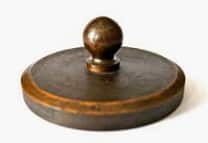 Pisapapel is a term that is not part of the dictionary of the Royal Spanish Academy ( RAE ) and whose use is incorrect. The reason is simple: said singular form ( paperweight ) does not exist, but is always used as a paperweight .
Pisapapel is a term that is not part of the dictionary of the Royal Spanish Academy ( RAE ) and whose use is incorrect. The reason is simple: said singular form ( paperweight ) does not exist, but is always used as a paperweight .
This is because the notion is developed with a verb plus a plural noun . “The paperweight” or “a paperweight,” therefore, are invalid expressions that must be replaced by “the paperweight” or “a paperweight.” In the plural, of course, it remains unchanged ( "the paperweights" , "some paperweights" ).
But, beyond these questions, what is a paperweight? This is an element that is used to prevent papers from moving . A paperweight is an object with a certain weight that, when placed on the sheets, prevents them from moving, flying, falling, etc.
The rise of paperweights began with the Industrial Revolution that began in the second half of the 18th century . At that time, documents began to multiply in companies and offices, due to the proliferation of correspondence, notifications, invoices and remittances, among many others that were prepared on sheets of paper. To immobilize these documents on desks and tables, heavy utensils capable of paralyzing them began to be used despite the wind or gusts of air, and thus the paperweight was born.
At first the paperweights were simply functional: they could be a rock , for example. Over time, design and aesthetics became important issues and thus paperweights became decorations and even small works of art that collectors value today.
Precisely, collecting and paperweights go hand in hand at a level that is difficult to imagine, with a large number of circles and associations that fiercely pursue these items , willing to pay large sums of money for them. The fanaticism for antique paperweights takes place in various parts of the world and is divided into different groups according to their most specific interests.
Among the various types of paperweights that collectors may prefer, the following two are the most common:
* chromatic compositions with more than one possible arrangement that are achieved with spherical paperweights with very small balls;
* those that were made of glass of different colors to represent plants, flowers or animals, a group in which there are some exponents that stand out for their level of detail and elegance.
 Paperweight collecting is even more complex, as it recognizes various historical periods in which designs followed certain trends in terms of shapes and materials, among other aspects. The three most important periods are the following:
Paperweight collecting is even more complex, as it recognizes various historical periods in which designs followed certain trends in terms of shapes and materials, among other aspects. The three most important periods are the following:
* classical : spread between the 1840s and 1880s, especially in the United States, the United Kingdom, and France;
* folkloric and advertising : it followed the classic and ended at the time of World War II. At that time, the most important glass factories went through considerable decline, a phenomenon that was complemented by the emergence of smaller farms;
* contemporary : emerged after World War II and is associated with the so-called study paperweight . The name refers to the fact that its production takes place in a studio, where the creators try to reproduce the techniques of the classical period.
Today, paperweights are still present in some offices , despite the fact that computing has done away with a large part of paper documents. Given today's needs, there are paperweights with cavities for a mobile phone and a pen, for example, among other creative designs that make them much more functional than a simple heavy object.
